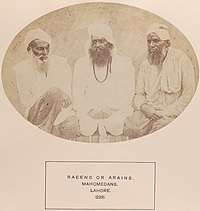Arain
Arain (also known as Raeen) are a large Punjabi agricultural tribe with strong political identity and organisation, found mainly in the Pakistani provinces of Punjab and Sindh with a small population in parts of Indian Punjab, Uttar Pradesh and Uttarakhand.[1]
| Arain | |
|---|---|
| Raeen, Rain or Arai | |
 Raeens or Arains, Mahomedans, Lahore | |
| Religions | Islam |
| Languages | Punjabi |
| Country | Primarily Pakistan and India |
| Region | Punjab and Sindh and Uttar Pradesh |
Origins
The historian and political scientist Christophe Jaffrelot believes that the Arain are displaced farming communities who moved to Punjab from Sindh and Multan as Arab Muslim armies encroached; they originally practised Hinduism but many later converted to Islam. He says that the community is related to the Kamboj Rajput community mainly located in northern India and eastern Pakistan.[2]
Ishtiaq Ahmed, a political scientist who is also a member of the Arain community, acknowledges that some early Arain texts ascribe a Suryavanshi Rajput origin, while others note a Persian one to reflect to others the status of being “conquerers”. He believes that the Arains "are a mix of many ethnicities and races", similar to other "farming castes of the Punjab and Haryana".[3]
British Raj period in Colonial India
According to Ahmed, during the Mughal and Sikh periods some Arains held prominent positions, such as governors and army generals; he also believes that numerous names adopted by the community may indicate a tradition of military employment.[4]
At the end of the period of governance mostly by the British East India Company, the rebel leaders of the 1857 uprising included Shah Abdul Qadir Ludhianvi, whose actions with fellow Arains were in part why the authorities of the newly-created British Raj subsequently considered the tribe to be dangerous, leading to them being denied recruitment to the army and having lands confiscated. This treatment was also applied to many other of the rebellious communities.[4]
Later, in Lahore District of British India, the Arain were the main Muslim landowning group among those located close to the urban areas, whilst Jats held a similar position in the rural areas. When the British wanted land developed in the Punjab Province, the Arain were brought in to cultivate lands around the cities, and were one of the agricultural communities given preference to assist with the opening up of the agrarian frontier in the Canal Colonies between 1885 and 1940.[5]
Traditionally associated with farming,[6][7] Shahid Javed Burki says that the British favoured the Arain for their "hard work, frugality and sense of discipline". Subsequent development of towns and cities and increasing urbanisation resulted in the value of the land settled by Arain to rise significantly, and Arain families thus flourished. Education was prioritised with the new-found wealth and the Arain came to dominate the legal profession amongst urban Punjabi Muslims. Many used law to enter politics.[8]
Although at first denied entry to the British Indian Army following the events of 1857, in the early 20th century the Arain were classified by the Raj as an "agricultural tribe", which was then effectively synonymous with the "martial race" classification.[9]
Organisation
Several meetings were held to establish an organisation to represent the Arain community in the 1890s. Eventually, in 1915, Anjuman Ra’iyan-i-Hind emerged as such a body in Lahore and a national community newspaper, titled Al-Rai, was established.[10]
Culture
The Arains are in majority in Lahore and this biradari is also active in industrial and commercial activities. A few families play a significant role in the politics of Lahore at national and local level.[10]
Diaspora
There are several diasporic Arain communities in British towns and cities, such as Manchester and Oxford.[11] The tribe has its own organisation, Arain Council UK, which was established as Anjuman-e-Arains in the 1980s and renamed in 2008.[12]
Notable people
- Adina Beg, last Mughal Governor of Punjab.[13]
- Muhammad Zia-ul-Haq, the 6th President of Pakistan[8]
References
- Katherine Pratt Ewing (1997). Arguing sainthood: modernity, psychoanalysis, and Islam. Duke University Press.
- Jaffrelot, Christophe (2004). A History of Pakistan and its Origins. trans. Beaumont, Gilliam. Anthem Press. pp. 154, 208. ISBN 9781843311492.
- Ahmed, Ishtiaq (18 April 2006). "There is many a slip betwixt cup and lip". Daily Times. Pakistan. Archived from the original on 15 July 2014. Retrieved 2014-06-15.
- Ahmed, Ishtiaq (15 December 2007). "An Arain freedom fighter". The News.
- Ali, Imran (1979). The Punjab Canal Colonies, 1885-1940 (Ph.D. thesis). Australian National University. p. 29. doi:10.25911/5d74e7b3b71c9.
- Binay Bhushan Chaudhuri. Peasant History of Late Pre-colonial and Colonial India, Volume 8. Center for studies in Civilization. p. 195. ISBN 9788131716885. Retrieved February 11, 2015.
- Low, Donald Anthony. Soundings in Modern South Asian History. University of California Press. p. 375. ISBN 978-0520007703.
- Burki, Shahid Javed (October 1988). "Pakistan under Zia, 1977-1988". Asian Survey. 28 (10): 1082–1100. doi:10.1525/as.1988.28.10.01p0206e. JSTOR 2644708. (subscription required)
- Rajit K. Mazumder (2003). The Indian Army and the Making of Punjab. Orient Blackswan. pp. 104–105. ISBN 978-81-7824-059-6.
- Ibrahim, Muhammad (2009), Role of Biradari System in Power Politics of Lahore: Post-Independence Period, Department of Political Science & International Relations Bahauddin Zakariya University Multan https://pdfs.semanticscholar.org/7237/b88f561d124c8c792cb2aec83c60dec7957f.pdf
- Shaw, Alison (2000). Kinship and Continuity: Pakistani Families in Britain. Psychology Press. p. 121. ISBN 978-90-5823-075-1.
- "About". Arain Council UK. Retrieved 2020-05-22.
- "Dina Arain: the master 'double game' player".
Further reading
- Koul, Ashish (2017). "Making new Muslim Arains: reform and social mobility in colonial Punjab, 1890s-1910s". South Asian History and Culture. 8 (1): 1–18. doi:10.1080/19472498.2016.1260348.